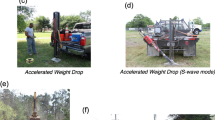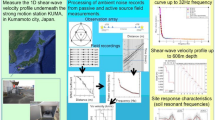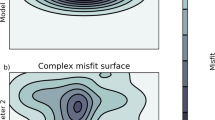Abstract
An efficient system for the joint acquisition and analysis of multi-component active and passive seismic data is presented. It is shown how, in spite of the limited field equipment (the system requires just a 4-channel seismograph, one 3-component and four vertical-component geophones), it is nevertheless possible to define up to seven different (but mutually related and complementary) objects used to constrain a multi-objective joint inversion capable of providing a robust subsurface shear-wave velocity (VS) profile for both geotechnical and seismic-hazard studies. The presented approach relies on acquisition techniques that require simple and straightforward field procedures useful in particular, but not solely, in the characterization of urban and remote areas where, due to logistical problems, standard acquisition procedures cannot be easily applied. Active data recorded by a single 3-component geophone are processed so to define up to five objective functions: the group-velocity spectra of the three components, the radial-to-vertical spectral ratio and the Rayleigh-wave particle motion frequency curve. Passive data are used to compute two further objects: the horizontal-to-vertical spectral ratio and the phase-velocity dispersion curve obtained via miniature array analysis of microtremors. These seven objects are jointly inverted by means of a multi-objective inversion procedure based on the Pareto criterion. Performances are assessed through a comprehensive field dataset acquired in an urban area of NW-Italy. The consistency of the overall procedure is assessed by comparing the results with the analyses accomplished by considering classical multi-channel active and passive data and methodologies (multi-component MASW, multichannel analysis of surface waves and ESAC, extended spatial auto-correlation).















Similar content being viewed by others
References
Abbate, E., Fanucci, F., Benvenuti, M., Bruni, P., Cipriani, N., Falorni, P., Fazzuoli, M., Morelli, D., Pandeli, E., Papini, M., Sagri, M., Reale, V., & Vannucchi, P. (2004). Carta Geologica d’Italia—F° 248—La Spezia. Regione Liguria. http://www.isprambiente.gov.it/Media/carg/note_illustrative/248_LaSpezia.pdf. Accessed June 2018 (extended English abstract).
American Society of Civil Engineers (ASCE). (2010). Minimum design loads for buildings and other structure, ASCE7-05, p 608. ISBN:0784410852.
Arai, H. & Tokimatsu, K. (2000). Effects of Rayleigh and Love waves on icrotremor H/V spectra. In: Proceedings of 12th world conference of earthquake engineering, Auckland, New Zealand, Paper no. 2232.
Arai, H., & Tokimatsu, K. (2004). S-wave velocity profiling by inversion of microtremor H/V spectrum. Bulletin of the Seismological Society of America, 94, 53–63.
Arai, H., & Tokimatsu, K. (2005). S-Wave velocity profiling by joint inversion of microtremor dispersion curve and horizontal-to-vertical (H/V) spectrum. Bulletin of the Seismological Society of America, 95, 1766–1778.
Asten, M. W. (2006). On bias and noise in passive seismic data from finite circular array data processed using SPAC methods. Geophysics, 71, 153–162.
Asten, M. W., Aysegul, A., Ezgi, E. E., Nurten, S. F., & Beliz, U. (2014). Site characterisation in north-western Turkey based on SPAC and HVSR analysis of microtremor noise. Exploration Geophysics, 45, 74–85.
Asten, M.W., Dhu, T., & Lam, N. (2004). Optimised array design for microtremor array studies applied to site classification; comparison of results with SCPT Logs. In Proceedings of the 13th world conference on earthquake engineering, Vancouver, paper 2903.
Asten, M. W., & Hayashi, K. (2018). Application of the spatial auto-correlation method for shear-wave velocity studies using ambient noise. Surveys In Geophysics, 39, 633–659.
Bhattacharya, S. N. (1983). Higher order accuracy in multiple filter technique. Bulletin of the Seismological Society of America, 73, 1395–1406.
Bonnefoy-Claudet, S., Köhler, A., Cornou, C., Wathelet, M., & Bard, P.-Y. (2008). Effects of Love waves on microtremor H/V ratio. Bulletin of the Seismological Society of America, 98, 288–300.
Bour, M., Fouissac, D., Dominique, P., & Martin, C. (1998). On the use of microtremor recordings in seismic microzonation. Soil Dynamics and Earthquake Engineering, 17, 465–474.
Brown, R. J., Stewart, R. R., & Lawton, D. C. (2002). A proposed polarity standard for multicomponent seismic data. Geophysics, 67, 1028–1037.
CEN (Comité Européen de Normalisation). (2004). EN 1998-5:2004b: Eurocode 8: Design of Structures for Earthquake Resistance—Part 1: General rules, seismic actions and rules for buildings. Brussels, Belgium: CEN.
Cho, I., Senna, S., & Fujiwara, H. (2013). Miniature array analysis of microtremors. Geophysics, 78, KS13–KS23.
Cho, I., Tada, T., & Shinozaki, Y. (2006). Centerless circular array method: Inferring phase velocities of Rayleigh waves in broad wavelength ranges using microtremor records. Journal of Geophysical Research, 111, B09315. https://doi.org/10.1029/2005JB004235.
Dal Moro, G. (2014). Surface wave analysis for near surface applications (p. 252). Oxford: Elsevier.
Dal Moro, G. (2015). Joint inversion of rayleigh-wave dispersion and HVSR of lunar seismic data from the Apollo 14 and 16 sites. Icarus, 254, 338–349.
Dal Moro, G., Moura, R. M., & Moustafa, S. R. (2015a). Multi-component joint analysis of surface waves. Journal of Applied Geophysics, 119, 128–138.
Dal Moro, G., Moustafa, S.R., & Al-Arifi, N. (2015b). Efficient acquisition and holistic analysis of Rayleigh waves. In Proceedings of the near-surface EAGE 2015 (Turin—Italy).
Dal Moro, G., Ponta, R., & Mauro, R. (2015c). Unconventional optimized surface wave acquisition and analysis: Comparative tests in a perilagoon area. Journal of Applied Geophysics, 114, 158–167.
Dal Moro, G., Keller, L., & Poggi, V. (2015d). A comprehensive seismic characterization via multi-component analysis of active and passive data. First Break, 33, 45–53.
Dal Moro, G., Keller, L., Moustafa, S. R., & Al-Arifi, N. (2016). Shear-wave velocity profiling according to three alternative approaches: A comparative case study. Journal of Applied Geophysics, 134, 112–124.
Dal Moro, G., Al-Arifi, N., & Moustafa, S. R. (2017a). Analysis of Rayleigh-wave particle motion from active seismics. Bulletin of the Seismological Society of America, 107, 51–62.
Dal Moro, G., Moustafa, S. R., & Al-Arifi, N. (2017b). Improved holistic analysis of rayleigh waves for single- and multi-offset data: Joint inversion of rayleigh-wave particle motion and vertical- and radial-component velocity spectra. Pure and Applied Geophysics, 175, 67–88. https://doi.org/10.1007/s00024-017-1694-8.
Dal Moro, G., & Pipan, M. (2007). Joint inversion of surface wave dispersion curves and reflection travel times via multi-objective evolutionary algorithms. Journal of Applied Geophysics, 61, 56–81.
Dal Moro, G., & Puzzilli, L. M. (2017). Single- and multi-component inversion of Rayleigh waves acquired by a single 3-component geophone: An illustrative case study. Acta Geodynamics et Geomaterialia, 14, 431–444. https://doi.org/10.13168/AGG.2017.0024.
Dimitriu, P., Kalogeras, I., & Theodulidis, N. (1999). Evidence of nonlinear site response in horizontal-to-vertical spectral ratio from near-field earthquakes. Soil Dynamics and Earthquake Engineering, 18, 423–435.
Dou, S., & Ajo-Franklin, J. B. (2014). Full-wavefield inversion of surface waves for mapping embedded low-velocity zones in permafrost. Geophysics, 79, EN107-EN124.
Dziewonski, A., Bloch, S., & Landisman, N. (1969). A technique for the analysis of transient seismic signals. Bulletin of the Seismological Society of America, 59, 427–444.
Fasan, M., Magrin, A., Amadio, C., Romanelli, F., Vaccari, F., & Panza, G. F. (2016). A seismological and engineering perspective on the 2016 Central Italy earthquakes. International Journal of Earthquake and Impact Engineering, 1, 395–420. https://doi.org/10.1504/IJEIE.2016.10004076.
Haghshenas, E., Bard, P. Y., Theodulidis, N., et al. (2008). Empirical evaluation of microtremor H/V spectral ratio. Bull Earthquake Eng, 6, 75–108. https://doi.org/10.1007/s10518-007-9058-x.
Herrmann, R. B. (2013). Computer programs in seismology: An evolving tool for instruction and research. Seismological Research Letters, 84, 1081–1088.
Herrmann, R.B. (2018). Computer programs in seismology. Open files. http://www.eas.slu.edu/eqc/eqccps.html. Accessed Aug 2018.
Ikeda, T., Asten, M.W., & Matsuoka, T. (2013). Joint inversion of spatial autocorrelation curves with HVSR for site characterization in Newcastle, Australia: Extended abstracts of the 23rd ASEG conference and exhibition. http://www.publish.csiro.au/ex/pdf/ASEG2013ab315. Accessed Aug 2018.
International Building Code (IBC). (2009). International Building Code. ISBN:580017258.
International Code Council (ICC). (2009). International Code Council. ISBN:978-1-58001-727-5.
Kacoaglu, A. H., & Long, L. T. (1993). A review of time-frequency analysis techniques for estimation of group velocities. Seismological Research Letters, 64, 157–167.
Lefebvre, G., & Karray, M. (2009). Techniques for mode separation in Rayleigh wave testing. Soil Dynamics and Earthquake Engineering, 29, 607–619. https://doi.org/10.1016/j.soildyn.2008.07.005.
Louie, J. N. (2001). Faster, better: Shear-wave velocity to 100 meters depth from refraction microtremor arrays. Bulletin of the Seismological Society of America, 91, 347–364.
Lunedei, E., & Albarello, D. (2009). On the seismic noise wavefield in a weakly dissipative layered Earth. Geophysical Journal International, 177, 1001–1014.
Luzón, F., Al Yuncha, Z., Sánchez-Sesma, F. J., & Ortiz-Alemán, C. (2001). A numerical experiment in the horizontal to vertical spectral ratio in flat sedimentary basins. Pure and Applied Geophysics, 158, 2451–2461.
Macau, A., Benjumea, B., Gabas, A., Figueras, S., & Vila, M. (2015). The effect of shallow Quaternary deposits on the shape of the H/V spectral ratio. Surveys In Geophysics, 36, 185–208.
Mark, N., & Sutton, G. H. (1975). Lunar shear velocity structure at Apollo sites 12, 14, and 15. Journal of Geophysical Research, 80, 4932–4938.
Nakamura, Y. (1989). A method for dynamic characteristic estimation of subsurface using microtremor on the ground surface. QR Railway Technique Research Institute, 30(1), 25–33.
Natale, M., Nunziata, C., & Panza, G.F. (2004). FTAN method for the detailed definition of V S in urban areas. In 13th World conference on earthquake engineering (p. 2694). Vancouver, B.C., Canada.
Ohori, M., Nobata, A., & Wakamatsu, K. (2002). A comparison of ESAC and FK methods of estimating phase velocity using arbitrarily shaped microtremor analysis. Bulletin of the Seismological Society of America, 92, 2323–2332.
Park, C. B., Miller, R. D., & Xia, J. (1999). Multichannel analysis of surface waves. Geophysics, 64, 800–808.
Picozzi, M., & Albarello, D. (2007). Combining genetic and linearized algorithms for a two-step joint inversion of Rayleigh wave dispersion and H/V spectral ratio curves. Geophysical Journal International, 169, 189–200.
Prodehl, C., Kennett, B., Artemieva, I. M., & Thybo, H. (2013). 100 years of seismic research on the Moho. Tectonophysics, 609, 9–44.
Ryden, N., Park, C. B., Ulriksen, P., & Miller, R. D. (2004). Multimodal approach to seismic pavement testing. Journal of Geotechnical and Geoenvironmental Engineering, 130, 636–645.
Sawaragi, Y., Nakayama, H., & Tamino, T. (1985). Theory of multiobjective optimization (p. 296). Orlando, Florida: Academic.
Scales, J.A., Smith, M.L., & Treitel, S. (2001). Introductory geophysical inverse theory (p. 193). Open file, Samizdat Press. http://www.e-booksdirectory.com/details.php?ebook=9154. Accessed 21 Nov 2018.
Sleeman, R., van Wettum, A., & Trampert, J. (2006). Three-channel correlation analysis: A new technique to measure instrumental noise of digitizers and seismic sensors. Bulletin of the Seismological Society of America, 96(1), 258–271.
Tada, T., Cho, I., & Shinozaki, Y. (2007). Beyond the SPAC method: Exploiting the wealth of circular-array methods for microtremor exploration. Bulletin of the Seismological Society of America, 97, 2080–2095.
Tada, T., Cho, I., & Shinozaki, Y. (2009). New circular-array microtremor techniques to infer love-wave phase velocities. Bulletin of the Seismological Society of America, 99, 2912–2926.
Tokeshi, J. C., Karkee, M. B., & Sugimura, Y. (2006). Reliability of Rayleigh wave dispersion curve obtained from f–k spectral analysis of microtremor array measurement. Soil Dynamics and Earthquake Engineering, 26, 163–174. https://doi.org/10.1016/j.soildyn.2005.02.013.
Tokimatsu, K., Tamura, S., & Kojima, H. (1992). Effects of multiple modes on rayleigh wave dispersion characteristics. Journal of Geotechnical Engineering, 118, 1529–1543.
Tong, V. C. H., & Garcia, R. A. (Eds.). (2015). Extraterrestrial seismology (p. 491). Cambridge: Cambridge University Press. https://doi.org/10.1017/CBO9781107300668.
Zealand. (2004). NZS 1170.5:2004 Structural design actions part 5: Earthquake actions-New Zealand. New Zealand.
Zitzler, E., & Thiele, L. (1999). Multiobjective evolutionary algorithms: A comparative case study and the strength Pareto approach. IEEE Transactions on Evolutionary Computation, 3, 257–271.
Acknowledgements
This work was partly supported by the Institute of Rock Structure and Mechanics (Czech Academy of Sciences—Prague, CZ) in the framework of the long-term conceptual development project RVO 67985891 (Institute grant for the “Extreme Seismics” project). The author is also grateful to Prof. Herrmann for his help in clarifying the sign convention adopted by his Computer Programs in Seismology. The paper significantly benefitted from the comments and suggestions of two anonymous reviewers whose comments were highly appreciated.
Author information
Authors and Affiliations
Corresponding author
Rights and permissions
About this article
Cite this article
Dal Moro, G. Effective Active and Passive Seismics for the Characterization of Urban and Remote Areas: Four Channels for Seven Objective Functions. Pure Appl. Geophys. 176, 1445–1465 (2019). https://doi.org/10.1007/s00024-018-2043-2
Received:
Revised:
Accepted:
Published:
Issue Date:
DOI: https://doi.org/10.1007/s00024-018-2043-2
Keywords
- Surface wave dispersion
- Rayleigh waves
- Love waves
- joint inversion of seismic data
- holistic analysis of surface waves (HS)
- miniature array analysis of microtremors (MAAM)
- Rayleigh-wave particle motion (RPM)
- radial-to-vertical spectral ratio (RVSR)
- horizontal-to-vertical spectral ratio (HVSR)
- ESAC (extended spatial auto-correlation)
- MASW (multichannel analysis of surface waves)
- Vs30




